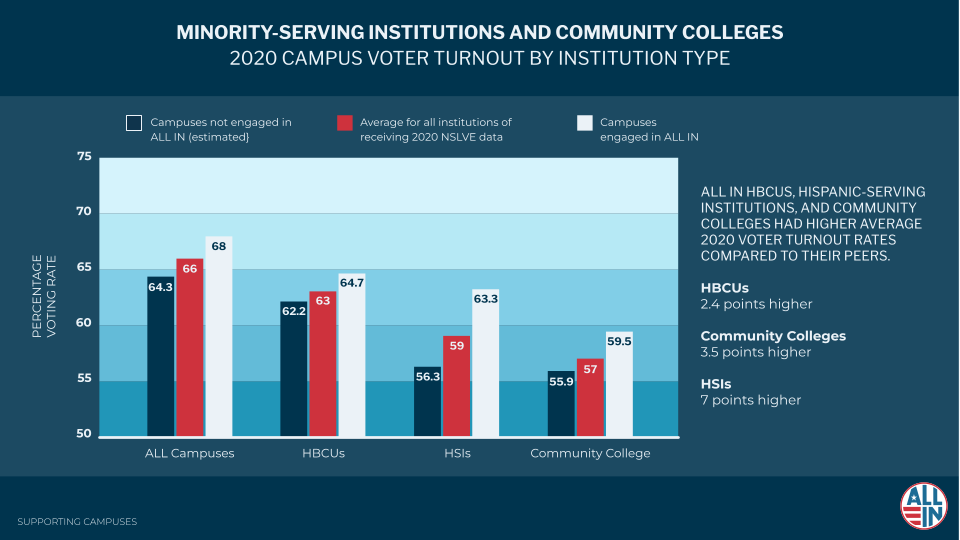Action planning is associated with higher 2020 voter turnout rates
Our analysis of the actions taken at more than 800 colleges and universities before the 2020 election shows institutions with democratic engagement action plans had higher student voting rates. Why?
Action planning is associated with higher turnout.
A record 66% of college students voted in the 2020 election, up 14 points from 52% in 2016. Our analysis of the more than 800 colleges and universities participating in the ALL IN Campus Democracy Challenge (ALL IN) before the 2020 election shows that higher education institutions that develop actions plan to increase nonpartisan democratic engagement saw higher 2020 student voter turnout rates.
Based on 2020 campus voting data from the National Study of Learning, Voting, and Engagement (NSLVE)1 that institutions shared with ALL IN, we know that campuses that participated in ALL IN had 2020 student voter turnout rates that were 3.7 points higher than campuses that didn’t engage with ALL IN.
These higher student voter turnout rates at campuses engaged with ALL IN were consistent across institution types including at Historically Black Colleges & Universities (HBCUs), community colleges, and Hispanic Serving Institutions (HSIs). HSIs, for instance, saw a seven percentage point higher student turnout rate than their peer institutions not engaged with ALL IN.
Institutions that participated in one of ALL IN’s 20 State and City Campus Voting Challenges or 12 Athletic Conference Voting Challenges during the 2020 election saw even higher student voting turnout rates on average at 70.2% and 71.1%, respectively.
The benefits of action planning add up over time.
The intentional efforts that colleges and universities put towards nonpartisan democratic engagement can yield benefits now and in the future. For example, institutions that submitted a 2020 democratic engagement action plan to ALL IN had an average 2020 student voter turnout rate that was 2 points higher than the national average of 66%. Those institutions that submitted an action plan in 2016 had 2020 student voting rates that were 3.5 percentage points higher. The longer an institution does student voting work, the greater gains in student voting rates they can see.
Campus leadership matters…
We also observed data suggesting that campus leadership is an essential part of institutionalizing nonpartisan democratic engagement and increasing student voting rates. At institutions where the president or chancellor signed the Higher Education Presidents’ Commitment to Full Student Voter Participation before the 2020 election, the average 2020 voter turnout rate was 73.2%, 5.7 percentage points higher than institutions without a campus leader's commitment.
… and so does wraparound support from partners.
Our data suggests that institutions benefit when they work with multiple nonprofit partner organizations and access more support and resources. The more partner organizations that a campus worked with, the higher their 2020 student voter turnout and registration rates. When institutions invest resources and staff time into nonpartisan democratic engagement efforts, they can see a double benefit by increasing their capacity to work with more nonprofit partner organizations.
Learning more about action planning and impact
Correlation is not causation. There is still so much to learn about the way in which institutional action planning for 100% student voting leads to higher student voting rates and builds power for our movement overall. That’s why we’re so excited to be establishing new research partnerships with scholars involved with SVRN who are helping us better understand the action planning process. Using methods like natural language processing and other tools we are able to learn more about the patterns that emerge from the thousands of action plans we’ve collected at ALL IN since 2016.
These questions are of urgent importance to communities across the country. Our data suggests that there is something about action planning that sparks a shift to a more inclusive community voting culture. But we know little beyond anecdotes about the mechanisms that drive those shifts, the strategies that most effectively inspire effective planning, and the way in which these strategies need to be adapted to meet the needs of diverse community contexts.
We invite all of you to join us in trying to find out! Please get in touch with me if you’re interested in collaborating with ALL IN on a study or would like to access data to better understand how action planning impacts campus communities.
Ryan Drysdale is the director of impact and state networks for the ALL IN Campus Democracy Challenge at Civic Nation.
The National Study of Learning Voting and Engagement is housed at the Institute for Democracy & Higher Education at Tufts University.






